Palisades Fire: Timeline of Key Events and Failures
December 2024–January 7, 2025: Pre-Fire Risk Assessment Ignored
Numerous public agencies, including the National Weather Service, issued warnings about extreme wildfire risk due to drought conditions and high winds (Berzon et. al., 2025). At the same time, the Santa Ynez Reservoir was empty during the firefighting efforts, and water levels at other reservoirs were already reported below emergency readiness thresholds. Subsequent Los Angeles Times reports found that officials also failed to act on recommendations to pre-stage additional water tenders in hillside areas (Harter, 2025; Los Angeles Times, 2025).
Weeks before the wildfires, Fire Chief Kristin M. Crowley warned that budget cuts had severely limited the department’s ability to prepare for and respond to major emergencies, noting reduced capacity to handle wildfires, earthquakes, hazmat incidents, and large catastrophes (Continuity Insights, 2025).
Critically, in the days before the fire, officials did not pre-deploy or keep on duty roughly 1,000 Los Angeles Fire Department firefighters and numerous engines, despite warnings of strong winds and dry conditions. As a result, only a small portion of available resources was immediately positioned to fight the fire (Los Angeles Times, 2025). At the time the fire broke out, only 19 firefighters were deployed to the area (Vigliotti, 2025).
The lack of effective forest management has been common throughout the state in recent decades, corresponding with the growing intensity of California wildfires. Tried and true strategies such as thinning trees and clearing underbrush have been deferred or ignored for decades. Governor Gavin Newsom (D-CA) himself acknowledged this failure at a press conference with President Trump in 2020 during that year’s devastating wildfires (Bloomberg News, 2020; Little Hoover Commission, 2018; Maher, 2024).
January 7, 2025: Fire Ignites
The Palisades Fire began on January 7, 2025, near the Pacific Palisades neighborhood in the City of Los Angeles, and was first reported around 10:30 a.m., initially burning 10 acres in the nearby mountains (Cal Fire, 2025a).
Almost immediately, first responders to the Palisades Fire faced access issues due to narrow hillside roads and overgrown brush that had not been cleared due to budget constraints (Taft, 2025). In this case, the Palisades Fire started as a brushfire and quickly tore through the region’s dense chaparral, which is especially vulnerable to high winds (Nesi & Downing, 2025).
The decades-long lack of effective forest management mirrors and is integrally tied to the incompetence reflected in the state’s other crises, including its explosion in the homeless population and the long-term maintenance of its water infrastructure. In particular, California state reports in the last decade have highlighted this link, noting that deferred repairs and upgrades to dams, aqueducts, and groundwater recharge systems have contributed to leaks, shortages, and contamination risks. Likewise, decades of underfunding for thinning, prescribed burns, and firebreak upkeep have allowed dangerous fuel levels to accumulate (California Legislative Analyst’s Office, 2019; California State Water Resources Control Board, 2025).
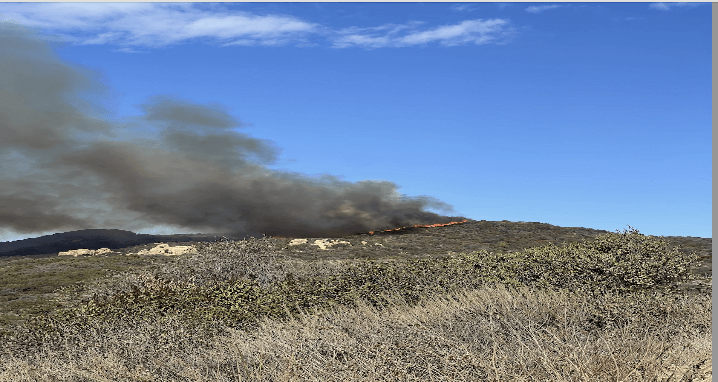
Image 1: Early stages of the Palisades Fire, with dry brush tinder visible in the foreground (Margolis, 2025).
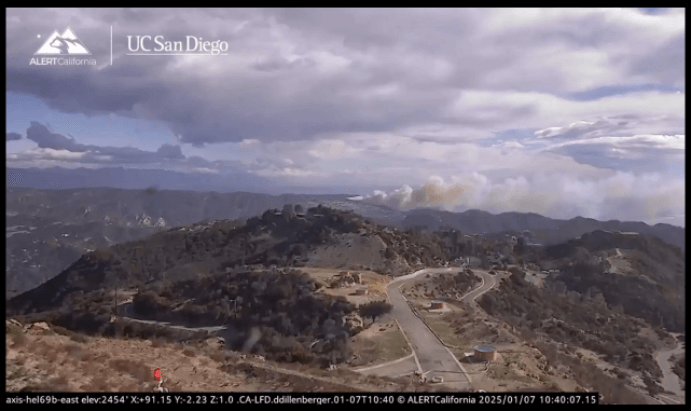
Image 2: The above image shows the early stages of the Palisades fire on January 7, 2025, within minutes of its official start (Nesi & Kennedy, 2025).
Homeowners in the area claim to have called emergency services within minutes of the fire’s start, only to get a busy signal. By some accounts, the first firefighters did not arrive in the area for some 45 minutes after the first calls to 9-1-1, by which time the fire had expanded to 10 acres. Additionally, inconsistent communication between firefighting agencies and emergency services led to further delays as response crews attempted to determine the fire’s location. By 11:30 a.m., the fire had grown to 200 acres (Nesi & Kennedy, 2025).
Later in the evening, the Eaton Fire began at 6:18 p.m. in Eaton Canyon near Altadena Drive and Midwick Drive, Altadena/Pasadena (California Fire, 2025b).
Mandatory evacuation orders were issued for more than 30,000 residents as the fire grew overnight (Office of Governor Gavin Newsom, 2025; Fox 11, 2025). Firefighting resources were stretched thin due to simultaneous fires in San Diego County (Bickerton, 2025).
January 7, 2025: State of Emergency Declared
Los Angeles Mayor Karen Bass formally declared a state of emergency at 7:58 p.m. as the Palisades Fire, with wind gusts as high as 100 miles per hour, was recorded (City of Los Angeles Office of the Mayor, 2025).
January 7–8, 2025: Hydrant Failures Begin
As winds intensified, fire spread into the Pacific Palisades and Topanga Canyon areas. Per the Los Angeles Mayor’s office, some 20% of fire hydrants failed as the water needed to fight the fire surpassed supplies. As the Los Angeles Department of Water and Power (LADWP) stated, at the start of the Palisades Fire, 3 million gallons of water were available, but within less than 24 hours, demand quickly surged to four times higher than any previously recorded levels in the system (Haskell, 2025; Peterson & Phillis, 2025). The lack of water was so extreme that aerial firefighting teams resorted to using ocean water despite the contamination risks salt water poses to the ecosystems (Kiszla, 2025).
January 8, 2025: Fire Expands, Relief Lags
Between the Palisades Fire and the Eaton Fire, evacuees spiked to more than 100,000, which overwhelmed firefighting and homeless infrastructure (NBC News, 2025).
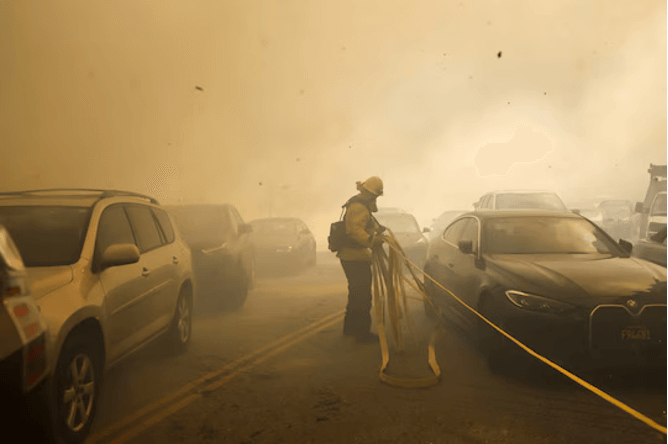
Image 3: A photo of a firefighter attempting to navigate his equipment through stalled cars of residents attempting to evacuate (Sacks, 2025).
Residents in several neighborhoods reported receiving evacuation alerts late or not at all (Keller et al., 2025). Simultaneously, millions of Southern California residents outside the evacuation zones received alerts telling them to evacuate, creating panic and confusion. Although a correction was issued 20 minutes after the first mistaken alerts, there were reports that additional mistaken alerts continued throughout the day (Juarez, 2025).
While shelters in Santa Monica and Malibu were opened during these days, they were quickly overwhelmed, leaving many to sleep in vehicles or even outdoors (Healy & Jimenez, 2025).
Overall, residents’ evacuation of the Palisades area was chaotic as firefighting crews attempted to enter the fire area, navigating narrow roads that were overwhelmed by evacuees attempting to leave. Many evacuees were reported to have abandoned their cars to avoid being overtaken by the fast spreading flames while major thoroughfares were closed (Wenzke, 2025).
January 9, 2025: Fire Crosses Pacific Coast Highway
In a major escalation, there were reports that embers and some flames crossed California Highway 1, also known in the region as the Pacific Coast Highway, near the intersection with Temescal Canyon (California Fire, 2025c). Additionally, several structures were destroyed, and parts of the highway were closed until May 2025. At the time of the fire, the closure was noted to complicate evacuation and logistics further (California Department of Transportation, 2025).
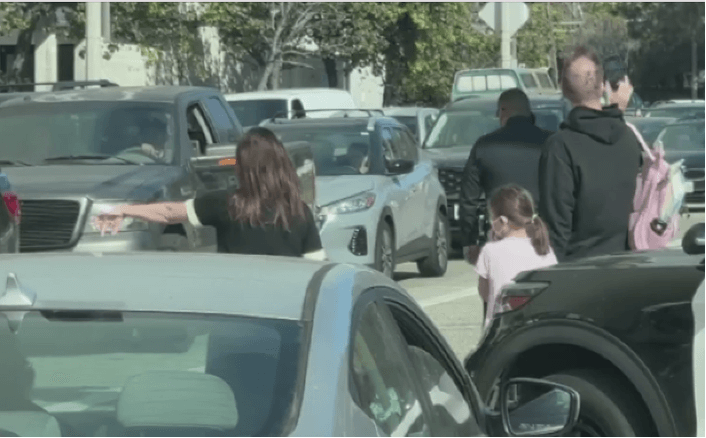
Image 4: Residents abandon their cars and attempt to flee the fire area on foot as the Pacific Coast Highway and other thoroughfares are closed (Wenzke, 2025).
January 10, 2025: Governor’s Office Press Briefing
State officials held a briefing acknowledging critical failures in reservoir oversight. The governor’s office cited deferred maintenance, lack of emergency storage reserves, and inadequate water supply tracking systems (Hamilton, 2025).
January 12, 2025: Newsom Mingles His Political Fundraising with Fire Victim Relief
Governor Newsom faces a wave of criticism after asking for donations through an ActBlue fundraiser, which is tied to his super PAC, while also raising money for wildfire victims and first responders (Halff, 2025).
January 15, 2025: Federal and State Relief Delays
The Federal Emergency Management Agency (FEMA) approved disaster relief for fire victims, but the California Office of Emergency Services (Cal OES) had not processed any individual household assistance claims more than a week into the fire. A major contractor system outage stalled intake and verification. Reports revealed that nearly 80% of uninsured homeowners in burn zones were still waiting for official damage assessments required for aid applications (Lindenfeld, 2025).
January 24, 2025: Report Reveals Los Angeles County Missed Water Infrastructure Upgrades Before Palisades Fire
The Los Angeles Times reported that Los Angeles County repeatedly delayed or abandoned water infrastructure projects that experts believe could have improved firefighting efforts during the January 2025 Palisades fire. Many planned upgrades going back more than a decade were designed to increase “fire flow” and storage capacity in Malibu and Topanga, including more than 1 million gallons of new water storage, replacement of deteriorated tanks, pumping station upgrades, and an emergency connection to the Las Virgenes Municipal Water District. Officials blamed red tape and budget shortfalls for the delays, with 12 of the 13 priority projects still incomplete by the fire’s outbreak (Sheets, 2025).
January 20–24, 2025: Inconsistent Debris Removal
FEMA and Cal OES initiated debris removal but initially skipped substructure soil sampling 6 inches into the soil beneath burned properties, which is a key protocol since the 2018 Camp Fire. State and federal agencies disagreed on who would bear the financial responsibility for this testing and disagreed about whether following this protocol was necessary (California Office of Emergency Services, 2025; Stone, 2025).
January 27–31, 2025: Residents Return, but Not Given Guidance to Avoid Toxic Soil Contamination
As evacuation restrictions were lifted, residents were not given guidance to avoid gardening, topsoil exposure, or playing in the yard. Subsequent tests in the area revealed dangerously toxic levels of arsenic and other carcinogens. Additionally, jurisdictional confusion between the California Environmental Protection Agency, the Department of Toxic Substances Control, and Los Angeles County left the public without clear information. There were several reports that residents had already begun DIY soil removal or rebuilding activities without official safety protocols in place (Hoey, 2025; Briscoe et al., 2025).
In fact, the overlap in jurisdictions has yielded fragmented responses that have impeded effective forest management. Just as the overlapping federal, state, and local jurisdictions caused confusion and even conflict between agencies in responding to potentially toxic soil from the Palisades Fire, the U.S. Government Accountability Office found that overlapping responsibilities between the U.S. Forestry Service, Bureau of Land Management, Cal Fire, and local agencies directly contributed to delays in clearing years of dead brush and tinder, which would have arguably prevented or even at least lessened the intensity of recent state wildfires (U.S. Government Accountability Office, 2024).
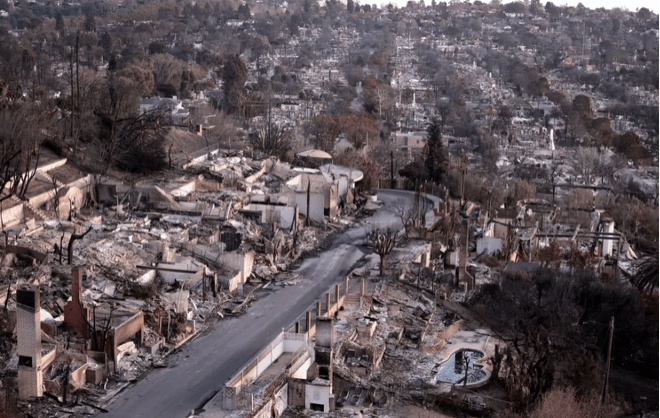
Image 5: Residents returned to ruined homes in the Pacific Palisades, January 2025 (Campa et al., 2025).
January 26, 2025: Community Hearings Begin
Town halls in Santa Monica and elsewhere in the county drew hundreds of residents voicing outrage at the slow emergency response and lack of post-fire support. Local and state officials faced questions on water access, evacuation timelines, and insurance denial issues (Smith, 2025).
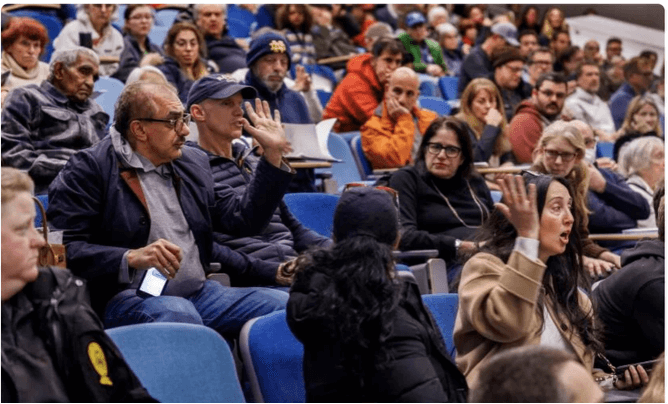
Image 6: Pacific Palisades residents voiced frustrations during a January 26, 2025, town hall on debris removal at Santa Monica College (Smith, 2025).
January 30, 2025: FireAid Concert Held to Raise Money for Fire Victims
The much-anticipated FireAid benefit concert takes place, pulling in an estimated $100 million under the premise of direct assistance for wildfire victims (Iasimone, 2025).
January 31, 2025: Full Containment
Cal Fire and the Los Angeles County Fire Department officially declared the Palisades Fire 100% contained (Romero, 2025).
February 2025: Initial Disbursement of FireAid Funds
FireAid disburses the first round of grants, totaling $50 million, to more than 120 nonprofit organizations (Iasimone, 2025).
February 2, 2025: U.S. Environmental Protection Agency Releases Initial Soil Remediation Guidelines and Responsibilities
The U.S. Environmental Protection Agency issues a preliminary outline for how it will carry responsibility for remediation requirements. They also note the type of soil remediation that ought to be ordered (Environmental Protection Agency, 2025).
March and April 2025: Toxic Soil Contamination Uncovered
Independent soil tests by residents revealed elevated lead and arsenic levels in numerous backyards while insurance companies denied many cleanup claims (Briscoe et al., 2025).
March 2025 to Present: Ongoing Litigation Against Public Agencies
Lawsuits were filed against the LADWP and the County of Los Angeles. Plaintiffs alleged negligence in fire road clearance, sensor deactivation, and the abandonment of firebreak programs approved in prior years (Harter, 2025).
March 26, 2025: LA County Releases General Guidelines for Properties That Do Not Qualify for Government-Sponsored Debris Removal
The Los Angeles County Department of Public Health (LA DPH) issued broad and nonspecific guidelines for properties ineligible for the government-run debris removal program. The guidance focuses on methods of disposal and not necessarily on the potential toxins property owners may encounter (Los Angeles Department of Public Health [LA DPH], 2025).
April 10, 2025: Elevated Toxic Metal Concentrations in Fire-Affected Areas
LA DPH released preliminary soil contamination findings, indicating various toxic metals were detected above health screening levels. Specifically, arsenic was found at multiple residential and public sampling locations at levels exceeding California Human Health Screening Levels. Additionally, lead was found elevated in ash and topsoil in burned areas, particularly near destroyed structures. To a lesser extent, cadmium, chromium, and nickel were detected above background levels at certain locations. The report noted that concentrations were often higher in areas with burned older homes (due to legacy lead-based paint, treated wood, and older roofing materials) (Briscoe et al., 2025; LA DPH, 2025).
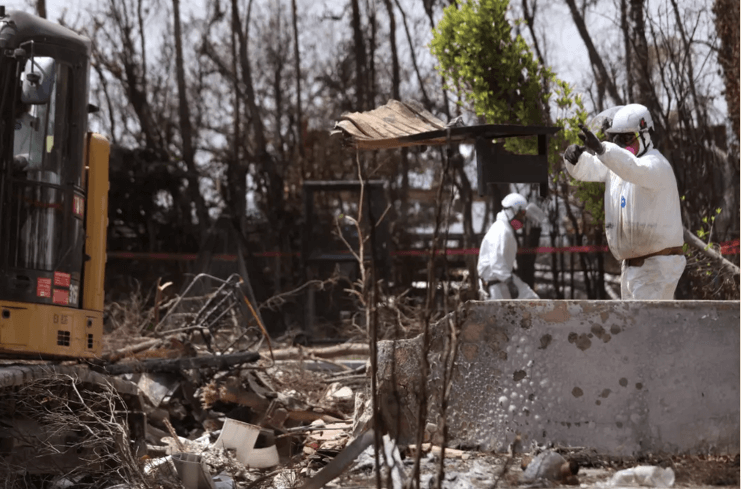
Image 7: Workers remove debris from a home destroyed in the Palisades fire, under the supervision of the Army Corps of Engineers (Briscoe et al., 2025).
May 2025: FireAid Comes Under Fire
The Palisades Community Council sends a critical letter to the Annenberg Foundation and FireAid organizers, demanding a full accounting of grants and clarity on the decision-making process (Brown, 2025; Santa Monica Mirror, 2025).
June 4, 2025: Second Round of Grants Issued While Questions Arise Over Missing Direct Aid
In June, FireAid distributed a second round of grants, totaling $25 million, to partner nonprofits. Meanwhile, concerns are raised about where the funds from the FireAid benefit concert are going, with many residents reporting they have not received direct assistance (Chidbachian, 2025).
July 2025: Army Corps of Engineers Updates Progress on Debris and Burned Structure Removal
Some six months after the Palisades Fire, the U.S. Army Corps of Engineers (USACE) provided an update regarding debris removal. USACE claims to have completed 90% of these efforts, but the logistical challenges of clearing hillside structures and the special environmental precautions near the ocean have slowed the effort considerably (U.S. Army Corps of Engineers, 2025).
July 17, 2025: Additional Concerns Surface
Reports emerge that many LA fire victims are still waiting for aid despite the $100 million raised by FireAid (Santos, 2025).
July 22, 2025: Critics Say FireAid Funds Bypassed Victims as Congressman Calls for Investigation
Commentary questions the FireAid distribution model, noting that none of $100 million in funds raised went to fire victims, but rather to nongovernmental organizations (NGOs) and nonprofits, suggesting that only a small percentage of donations might actually reach the cause; Congressman Kevin Kiley (CA-03) requests Attorney General Pam Bondi investigate (Kiley, 2025).
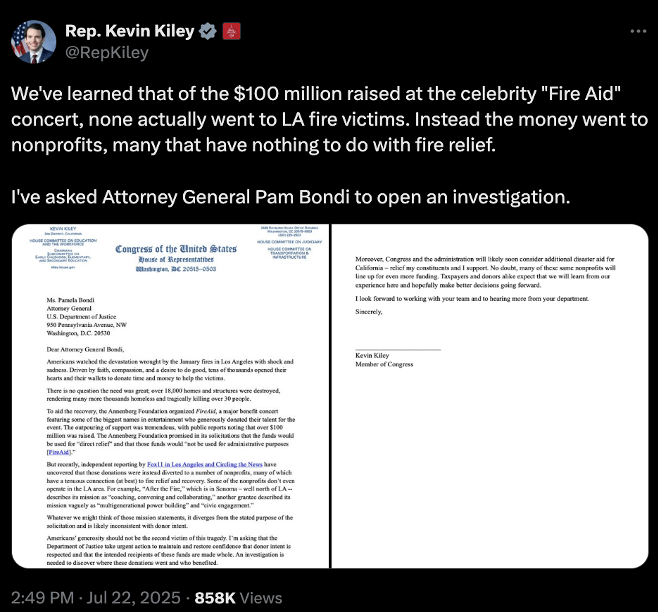
Image 8: Post by Rep. Kiley announcing his call for the U.S. Department of Justice to investigate grants made by FireAid.
Here, the lack of ability to track relief spending mirrors precisely the state’s incompetence at tracking the $24 billion in public funds it appropriated for homelessness relief between 2018 and 2023. In fact, the California Auditor’s Office released a report in April 2024 noting that California “does not currently have a method to track spending across programs comprehensively or to determine whether this spending is helping to reduce homelessness” (California State Auditor, 2024).
In what is a microcosm of the debacle in state homeless spending, FireAid relief has largely been appropriated to NGOs and nonprofits without direct relief for fire victims. In both cases, funds are funneled to intermediaries while the state is unable to ascertain the efficacy of these funds in aiding the very people they were expected to help.
July 23, 2025: LA Times Takes Note of Irregularities
The Los Angeles Times reports on the use of FireAid funds, stating the organization partnered with area nonprofits to distribute aid (Brown, 2025).
July 25–27, 2025: Outrage Intensifies Over Distribution of FireAid Funds
Criticism intensifies as the California Globe reports that the $100 million FireAid funds went to nonprofits instead of fire victims, while many victims question where the money went (Symon, 2025).
July 30–31, 2025: Third Party Oversight Elicited
FireAid hires big law firm Latham and Watkins to conduct an independent review of its governance and grant-making process in response to the growing criticism. It also contracts KPMG to conduct an audit (Green, 2025). At the same time, Governor Newsom’s plan to raise an additional $18 billion for the state wildfire fund faces opposition, given the lack of accountability for how funds already raised have been spent. (Peterson, 2025).
August 2025: Additional Inquiries from Alternative News Sources
Independent Voter News and Megyn Kelly report on the political furor surrounding FireAid, including President Donald Trump’s condemnation of the situation (Brown-McCormick, 2025; Storm, 2025).
